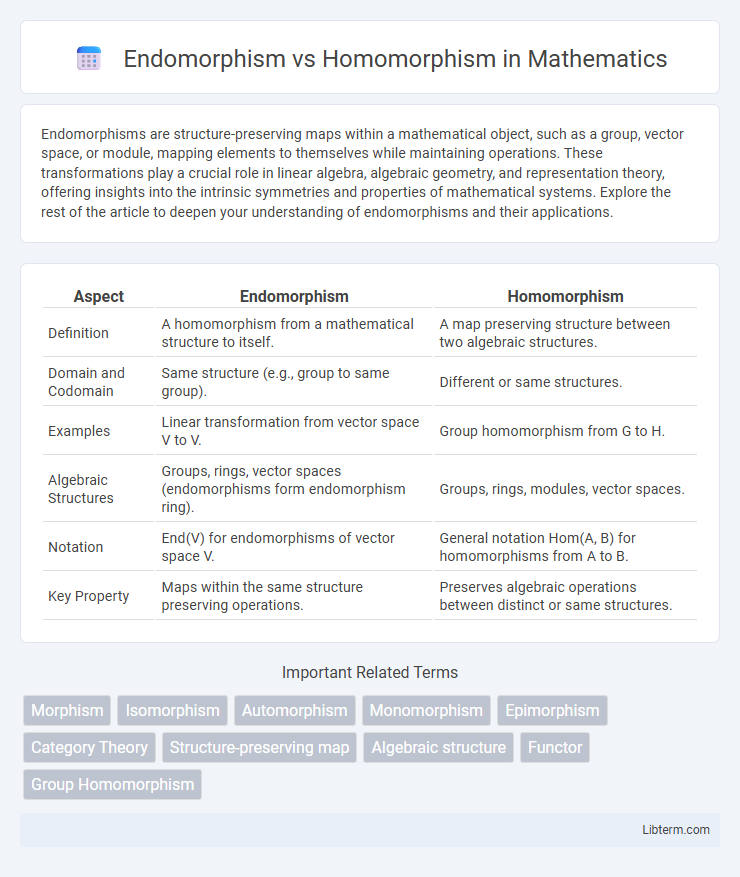Endomorphisms are structure-preserving maps within a mathematical object, such as a group, vector space, or module, mapping elements to themselves while maintaining operations. These transformations play a crucial role in linear algebra, algebraic geometry, and representation theory, offering insights into the intrinsic symmetries and properties of mathematical systems. Explore the rest of the article to deepen your understanding of endomorphisms and their applications.
Table of Comparison
| Aspect | Endomorphism | Homomorphism |
|---|---|---|
| Definition | A homomorphism from a mathematical structure to itself. | A map preserving structure between two algebraic structures. |
| Domain and Codomain | Same structure (e.g., group to same group). | Different or same structures. |
| Examples | Linear transformation from vector space V to V. | Group homomorphism from G to H. |
| Algebraic Structures | Groups, rings, vector spaces (endomorphisms form endomorphism ring). | Groups, rings, modules, vector spaces. |
| Notation | End(V) for endomorphisms of vector space V. | General notation Hom(A, B) for homomorphisms from A to B. |
| Key Property | Maps within the same structure preserving operations. | Preserves algebraic operations between distinct or same structures. |
Introduction to Morphisms in Mathematics
Morphisms are structure-preserving maps between mathematical objects, central to fields like algebra and category theory. A homomorphism is a map between two algebraic structures of the same type that respects the operations defining those structures. An endomorphism is a homomorphism where the domain and codomain are identical, making it a self-map that preserves the internal structure.
Defining Homomorphism: Core Concepts
Homomorphism is a structure-preserving map between two algebraic structures, such as groups, rings, or vector spaces, ensuring that the operation defined in the domain is compatible with the operation in the codomain. Core properties of homomorphisms include preserving identity elements and operation results, making them fundamental in studying algebraic system similarities. Unlike general mappings, homomorphisms allow algebraic structures to interact systematically, enabling the analysis of kernels, images, and isomorphisms.
Understanding Endomorphism: An Overview
Endomorphism is a homomorphism where the domain and codomain are the same algebraic structure, such as a group, ring, or vector space. It preserves the structure's operations, ensuring elements map within the same set while maintaining algebraic properties like addition or multiplication. Understanding endomorphisms is critical for studying internal symmetries and structural invariants within mathematical objects.
Key Differences Between Endomorphism and Homomorphism
Endomorphisms are specific homomorphisms where the domain and codomain are the same algebraic structure, preserving its operation within itself, while homomorphisms map between potentially different structures. The key difference lies in endomorphisms being self-maps, often used to analyze internal symmetries or structure-preserving transformations, whereas homomorphisms enable comparison and transfer of properties across different algebraic systems. Endomorphisms form monoids under composition, highlighting their role in internal structural analysis, opposed to homomorphisms that emphasize relational mappings between distinct algebraic entities.
Mathematical Examples of Homomorphism
A homomorphism is a structure-preserving map between two algebraic structures, such as groups, rings, or vector spaces, where the operation is maintained, for example, the function f: \(\mathbb{Z} \to \mathbb{Z}/n\mathbb{Z}\) defined by \(f(a) = a \mod n\) preserves addition. An endomorphism is a special type of homomorphism where the domain and codomain are the same structure, like the map \(f: \mathbb{R} \to \mathbb{R}\) defined by \(f(x) = 2x\), which preserves vector addition. The distinction lies in the codomain, with endomorphisms acting internally on one structure, while homomorphisms can map between different algebraic entities.
Illustrative Examples of Endomorphism
An endomorphism is a homomorphism from a mathematical structure to itself, such as functions from a vector space to itself preserving vector addition and scalar multiplication. For example, the linear map \( f: \mathbb{R}^2 \to \mathbb{R}^2 \) defined by \( f(x, y) = (2x, 3y) \) is an endomorphism of the vector space \( \mathbb{R}^2 \). In contrast, a homomorphism can map between different structures, like \( g: \mathbb{Z} \to \mathbb{Z}_n \), which is not an endomorphism since the codomain differs from the domain.
The Role of Structure Preservation
Endomorphisms are structure-preserving maps from an algebraic structure to itself, ensuring the internal operations remain consistent within the same set, while homomorphisms map between different structures, maintaining the integrity of operations across distinct sets. The role of structure preservation in both concepts is crucial, as it guarantees that the algebraic properties, such as group operations or ring addition and multiplication, are maintained, enabling meaningful comparisons and transformations. This preservation allows homomorphisms to facilitate the study of algebraic objects by relating them, while endomorphisms explore the internal symmetries and automorphisms within a single structure.
Applications in Algebra and Beyond
Endomorphisms serve as vital tools in algebra for studying internal symmetries of structures like groups, rings, and vector spaces by mapping these structures onto themselves while preserving operations. Homomorphisms extend this concept by connecting different algebraic structures, facilitating the analysis of their relationships and enabling the transfer of properties across groups, rings, and modules. Beyond pure algebra, these mappings underpin cryptographic algorithms, coding theory, and the study of automata, highlighting their interdisciplinary applications in computer science, physics, and information theory.
Visualizing Morphisms: Diagrams and Representations
Visualizing morphisms in category theory involves diagrams that depict objects as nodes and morphisms as arrows, emphasizing structure-preserving mappings between objects. Endomorphisms are represented as loops from an object to itself, illustrating transformations within a single structure, while homomorphisms appear as arrows connecting different objects, highlighting the structure-preserving mappings between distinct algebraic structures. These diagrammatic representations provide intuitive insights into the nature of these morphisms and their roles in mathematical frameworks.
Summary: Choosing Between Endomorphism and Homomorphism
Endomorphisms are homomorphisms where the domain and codomain are identical, often simplifying algebraic structure analysis within a single set. Homomorphisms map between different algebraic structures, facilitating the study of structural similarities and functional mappings across diverse sets. Choosing between endomorphism and homomorphism depends on whether the focus is on internal structure transformations or relationships between distinct algebraic systems.
Endomorphism Infographic

 libterm.com
libterm.com